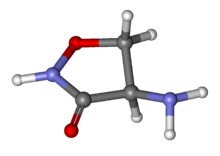Cycloserine
 | |
 | |
| Clinical data | |
|---|---|
| Trade names | Seromycin |
| AHFS/Drugs.com | Monograph |
| Pregnancy category |
|
| ATC code | |
| Pharmacokinetic data | |
| Bioavailability | ~70% to 90% |
| Metabolism | Hepatic |
| Elimination half-life | 10 hrs (normal renal function) |
| Excretion | Renal |
| Identifiers | |
| |
| CAS Number | |
| PubChem CID | |
| DrugBank | |
| ChemSpider | |
| UNII | |
| KEGG | |
| ChEBI | |
| ChEMBL | |
| NIAID ChemDB | |
| CompTox Dashboard (EPA) | |
| ECHA InfoCard | 100.000.626 |
| Chemical and physical data | |
| Formula | C3H6N2O2 |
| Molar mass | 102.092 g/mol g·mol−1 |
| 3D model (JSmol) | |
| |
| |
| (verify) | |
Cycloserine is an antibiotic effective against Mycobacterium tuberculosis. For the treatment of tuberculosis, it is classified as a second line drug, i.e. its use is only considered if one or more first line drugs cannot be used.
Although in principle active against other bacteria as well, cycloserine is not commonly used in the treatment of infections other than tuberculosis.
Mode of action
The terminal two amino acid residues of the murein precursor lipid II consist of D-alanine, which is produced by the enzyme alanine racemase; the two residues are joined by D-alanine ligase. Both enzymes are competitively inhibited by cycloserine.[1]
It is also being trialed as an adjuvant to exposure therapy for anxiety disorders (e.g. phobias[2]), depression, obsessive-compulsive disorder and schizophrenia. It has been experimentally used for treatment of Gaucher's disease.
Recent research suggests that D-cycloserine (d-4-amino-3-isoxazolidinone) may be effective in treating chronic pain.[3]
The side effects are mainly central nervous system (CNS) manifestations, i.e. headache, irritability, depression, psychosis convulsions. Co-administration of pyridoxine can reduce the incidence of some of the CNS side effects (e.g. convulsions).
These psychotropic responses are related to D-cycloserine's action as a partial agonist of the neuronal NMDA receptor for glutamate and have been examined in implications with sensory-related fear extinction in the amygdala,[2] and extinction of cocaine seeking in the nucleus accumbens.[4]
D-cycloserine is a partial agonist at the glycine receptor, and has been shown to have cognition-enhancing properties for models of Parkinsons disease in primates.[5]
References
- ^ "Cell Envelope.1995". Retrieved 2008-11-08.
- ^ a b Davis, Michael (2005). "Facilitation of Extinction of Conditioned Fear by D-Cycloserine" (PDF). American Psychological Society. 14 (4): 214–219. doi:10.1111/j.0963-7214.2005.00367.x. Retrieved 2008-07-15.
{{cite journal}}: Unknown parameter|coauthors=ignored (|author=suggested) (help) - ^ "Newly Identified Drug Relieves Suffering". Science Daily. 2007-06-05. Retrieved 2008-07-15.
- ^ "Memory-boosting drug may help cocaine addicts avoid relapse". 2010-08-03.
- ^ "Effects of the partial glycine agonist D-cycloserine on cognitive functioning in chronic low dose MPTP-treated monkeys". 2000-03-17.
